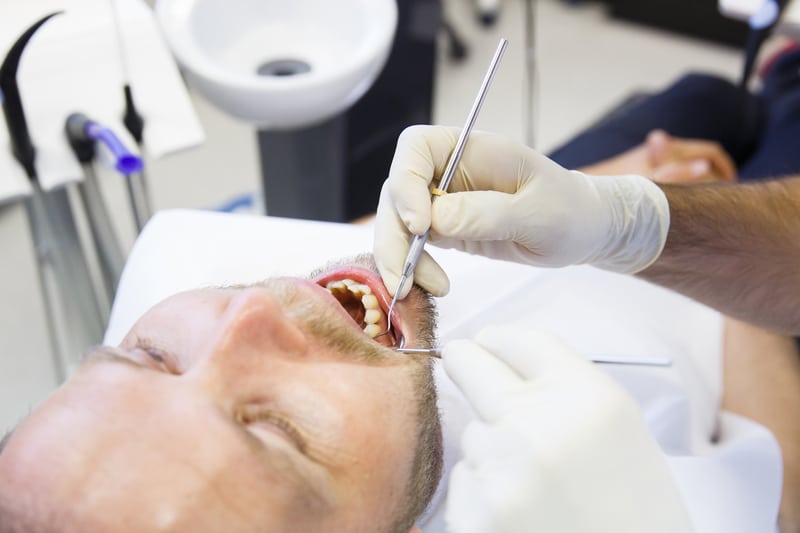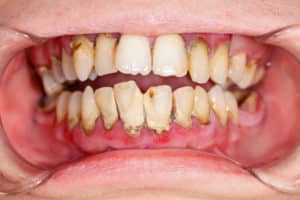Warning Signs for Gum Disease


Ever had your gums bleed when you’ve brushed your teeth? That bleeding is a warning sign for gum disease, even if your gums look like they are fine. There are various warning signs that present themselves in your mouth if you are at risk for full-blown gum disease. You want to notice those signs when they happen so you can take measures to get your oral health under control. Use this guide to know what to look for!
Gum Disease: What Is It?
When you hear the word “disease”, you don’t always think of the mouth. However, one of the most common diseases happens in your mouth. It’s called gum disease, and it’s a painless condition that can lead to tooth loss without intervention. Cavities are a common disease that is caused by sugar and poor oral hygiene. When you eat, sugars in your foods and drinks mix with mouth bacteria to create plaque. That plaque sticks to your teeth, decaying them as it breaks up the minerals.
At the same time, plaque is irritating your gums because it is acidic. In response, your gums become irritated and inflamed. If you don’t start brushing and flossing, the gums will simply start to pull away from plaque. With enough recession, the gums become mushy and your teeth start to fall out. Once a patient gets to that stage, there is little that can be done. That is why you want to notice the early warning signs for gum disease so you can avoid it.

Early Warning Signs
Statistics show that around 64.7 million Americans have gum disease. Many don’t even realize that they do because this is a painless condition until a patient gets to the severe stage of the disease. You have to notice the physical warning signs. Have you ever noticed darker red gums in your mouth? This is a warning sign of gum disease. When your gums are irritated, they become darker red and inflamed. They may even be swollen. However, the first sign for many patients is that the gums bleed much easier when you do brush and floss.
The bleeding is often the way that dentists can tell you’re not flossing enough. When you brush and floss often, your gums stay healthy and strong and they won’t bleed when they’re being cleaned. With gum disease, the gums will be much more sensitive and will bleed, even if you don’t notice the sensitivity. The mild stage of gum disease is called “gingivitis”. About 8.7% of Americans are in this stage, and about 30% have progressed to a moderate stage. That is likely due to not knowing that gingivitis is present or from not following oral hygiene practices. Look for all of these signs and change your eating and oral hygiene habits to reverse the problem while it is only in the gingivitis stage.
Periodontal Therapy
With gingivitis, dental cleanings and hitting the oral hygiene habits hard are usually the best ways to reverse your condition. In fact, many people have gingivitis and don’t even know it because it is so early-stage. You know you have it if you have the warning signs we mentioned. Check your mouth often for these signs. If you don’t notice them, we will tell you during your dental cleaning and comprehensive exam.
We do see patients with moderate and severe gum disease. With these patients, we have to take additional measures to either get gum disease under control or stop the progression. Scaling and root planing is one method we use on patients to avoid tooth loss. You may need this service if your gums are starting to pull away from the teeth or if you continuously have gum inflammation. Tartar often accompanies gum disease, so if you have tartar spread all the way down to the roots of your teeth, you will need planing and root scaling.
This is a treatment that cleans the gum pockets from bacteria, plaque and tartar. Without cleaning, those gum pockets can reach the point of infection, furthering damaging the teeth and gums. Scaling and root planing requires local anesthesia because it can be uncomfortable by how thorough it is. Afterwards, your gums can start healing from the plaque and substances that were hurting them. For patients with very advanced gum disease, gum grafts may be needed to help cover the teeth before tooth loss happens.

Great Oral Health Habits
Many Americans won’t ever have severe gum disease that leads to complete tooth loss. However, many will. Studies show that at least 8.5% of Americans have that severe stage of gum disease that you really can’t come back from. That is why dental intervention early-on is so important if you want to have the ability to eat normally throughout your life. Your body gives you warning signs of gum disease for a reason, and they are ones you want to listen to.
How are you supposed to know you have gum disease? Go to the dentist! These visits need to happen twice a year if you want to avoid oral health diseases that can be devastating to your smile. We can spot the early signs of gum disease before it ever gets to a bad stage. If you aren’t already, we will suggest that you brush your teeth 2-3 times a day for at least 2 minutes at a time. For sensitive gums, you will want to choose a soft-bristled toothbrush to protect your teeth and gums as you brush.
Make sure you’re flossing 1-2 times every day, as this gets 40% of your tooth surfaces that brushing misses. We often give patients gingivitis tablets or have other methods of helping them see what areas in their mouth aren’t getting cleaned enough. Practicing these habits and even adding in mouthwash and special gum disease products can help get your smile back to normal. For instructions on good oral health habits or questions about gum disease, call Dr. Ania’s office today at 303-443-0998!


